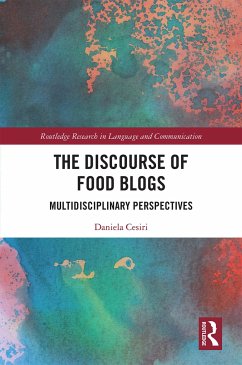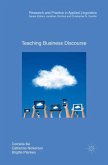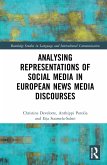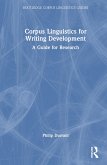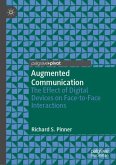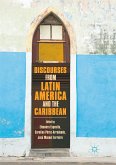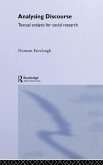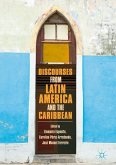- Gebundenes Buch
- Merkliste
- Auf die Merkliste
- Bewerten Bewerten
- Teilen
- Produkt teilen
- Produkterinnerung
- Produkterinnerung
This volume adopts a multidisciplinary perspective in analyzing and understanding the rich communicative resources and dynamics at work in digital communication about food.
Andere Kunden interessierten sich auch für
![Teaching Business Discourse Teaching Business Discourse]() Cornelia IlieTeaching Business Discourse44,99 €
Cornelia IlieTeaching Business Discourse44,99 €![Analysing Representations of Social Media in European News Media Discourse Analysing Representations of Social Media in European News Media Discourse]() Christine DevelotteAnalysing Representations of Social Media in European News Media Discourse200,99 €
Christine DevelotteAnalysing Representations of Social Media in European News Media Discourse200,99 €![Corpus Linguistics for Writing Development Corpus Linguistics for Writing Development]() Philip DurrantCorpus Linguistics for Writing Development180,99 €
Philip DurrantCorpus Linguistics for Writing Development180,99 €![Augmented Communication Augmented Communication]() Richard S. PinnerAugmented Communication41,99 €
Richard S. PinnerAugmented Communication41,99 €![Discourses from Latin America and the Caribbean Discourses from Latin America and the Caribbean]() Discourses from Latin America and the Caribbean88,99 €
Discourses from Latin America and the Caribbean88,99 €![Analysing Discourse Analysing Discourse]() Norman FaircloughAnalysing Discourse202,99 €
Norman FaircloughAnalysing Discourse202,99 €![Discourses from Latin America and the Caribbean Discourses from Latin America and the Caribbean]() Discourses from Latin America and the Caribbean88,99 €
Discourses from Latin America and the Caribbean88,99 €-
-
-
This volume adopts a multidisciplinary perspective in analyzing and understanding the rich communicative resources and dynamics at work in digital communication about food.
Hinweis: Dieser Artikel kann nur an eine deutsche Lieferadresse ausgeliefert werden.
Hinweis: Dieser Artikel kann nur an eine deutsche Lieferadresse ausgeliefert werden.
Produktdetails
- Produktdetails
- Verlag: Routledge
- Seitenzahl: 204
- Erscheinungstermin: 17. Februar 2020
- Englisch
- Abmessung: 235mm x 157mm x 16mm
- Gewicht: 454g
- ISBN-13: 9781138316102
- ISBN-10: 1138316105
- Artikelnr.: 58730676
- Herstellerkennzeichnung
- Books on Demand GmbH
- In de Tarpen 42
- 22848 Norderstedt
- info@bod.de
- 040 53433511
- Verlag: Routledge
- Seitenzahl: 204
- Erscheinungstermin: 17. Februar 2020
- Englisch
- Abmessung: 235mm x 157mm x 16mm
- Gewicht: 454g
- ISBN-13: 9781138316102
- ISBN-10: 1138316105
- Artikelnr.: 58730676
- Herstellerkennzeichnung
- Books on Demand GmbH
- In de Tarpen 42
- 22848 Norderstedt
- info@bod.de
- 040 53433511
Daniela Cesiri is Associate Professor in English Language and Translation in the Department of Linguistics and Comparative Cultural Studies at Ca'Foscari University of Venice, Italy.
Contents
List of figures
List of tables
Acknowledgments
Introduction
0.1. The language of/on food: state of the art
0.2. Blogs as narrative places to talk about food
0.3. This book
Part 1. Food Blogs: Introduction and Genre Analysis
Chapter One. Blogs and blogging. Origins, development and state of the art
in linguistics and communication studies
1.1. Introduction
1.2. Origins and development of blogs
1.2.1. The digital divide and the 'blogger' profile
1.3. Blogs as (virtual) communities
1.4. Blogs as a genre of computer-mediated communication (CMC)
1.5. Socio-cultural issues in blogs
1.6. Blogs and the other web 2.0 media
1.6.1. Why study blogs?
1.7. Conclusions: blogs in this book
Chapter Two. Food blogs as a genre of computer-mediated communication
2.1. Introduction
2.2. Food blogs: overview and state of the art
2.2.1. Food blogs as communities
2.2.2. State of the art
2.3. The corpus
2.3.1. The food bloggers: profiles and demographics
2.4. Defining food blogs as a web-mediated genre
2.5. Genre theory and genre analysis
2.6. Genre analysis of the UK-FBs corpus
2.6.1. Searching for structural patterns: the 'About Pages'
2.6.2. Searching for structural patterns: the 'Recipes Sections'
2.7. General remarks
Part Two. Visual Analysis
Chapter Three. The visual analysis of food blogs
3.1. Introduction
3.2. Multimodal analysis: theoretical-methodological framework
3.2.1. Multimodal analyses of hypertexts and their application to food
blogs
3.3. Multimodal analysis of the UK-FBs corpus: the homepages
3.4. Multimodal analysis of the UK-FBs corpus: the 'About Pages'
3.5. Multimodal analysis of the UK-FBs corpus: the 'Recipes Sections'
3.6. General discussion: metafunctions in the UK-FBs corpus
Part 2. Verbal Analysis
Chapter Four. The verbal discourse of food blogs: qualitative and
quantitative analyses
4.1. Introduction
4.2. The UK-FBs corpus: stylistic description
4.3. Qualitative analysis
4.3.1. Key keywords in the 'Recipes Sections' sub-corpus
4.3.2. Miscellaneous keywords and their collocations
4.4. Sensory language in he UK-FBs corpus
4.4.1. The language of food and its appeal to the senses
4.4.2. Sensory language in the 'Recipes Sections' of the UK-FBs corpus
4.4. Lexical priming in food blogs
4.5. Final remarks
Part four. (Critical) Discourse Analysis and Pragmatic Implications
Chapter Five. Food blogs as spaces of social interaction (and pragmatic
implications). Critical analysis of the 'About Pages' and of the 'Comments
Sections'
5.1. Introduction
5.2. Theoretical framework
5.2.1. The 'About Pages' as spaces of unequal power relations
5.3. Politeness and FT-/FSAs in the 'Comments Sections'
5.4. Shaping virtual personae in the UK-FBs corpus
5.5. Final remarks
Conclusions
References
Index
List of figures
List of tables
Acknowledgments
Introduction
0.1. The language of/on food: state of the art
0.2. Blogs as narrative places to talk about food
0.3. This book
Part 1. Food Blogs: Introduction and Genre Analysis
Chapter One. Blogs and blogging. Origins, development and state of the art
in linguistics and communication studies
1.1. Introduction
1.2. Origins and development of blogs
1.2.1. The digital divide and the 'blogger' profile
1.3. Blogs as (virtual) communities
1.4. Blogs as a genre of computer-mediated communication (CMC)
1.5. Socio-cultural issues in blogs
1.6. Blogs and the other web 2.0 media
1.6.1. Why study blogs?
1.7. Conclusions: blogs in this book
Chapter Two. Food blogs as a genre of computer-mediated communication
2.1. Introduction
2.2. Food blogs: overview and state of the art
2.2.1. Food blogs as communities
2.2.2. State of the art
2.3. The corpus
2.3.1. The food bloggers: profiles and demographics
2.4. Defining food blogs as a web-mediated genre
2.5. Genre theory and genre analysis
2.6. Genre analysis of the UK-FBs corpus
2.6.1. Searching for structural patterns: the 'About Pages'
2.6.2. Searching for structural patterns: the 'Recipes Sections'
2.7. General remarks
Part Two. Visual Analysis
Chapter Three. The visual analysis of food blogs
3.1. Introduction
3.2. Multimodal analysis: theoretical-methodological framework
3.2.1. Multimodal analyses of hypertexts and their application to food
blogs
3.3. Multimodal analysis of the UK-FBs corpus: the homepages
3.4. Multimodal analysis of the UK-FBs corpus: the 'About Pages'
3.5. Multimodal analysis of the UK-FBs corpus: the 'Recipes Sections'
3.6. General discussion: metafunctions in the UK-FBs corpus
Part 2. Verbal Analysis
Chapter Four. The verbal discourse of food blogs: qualitative and
quantitative analyses
4.1. Introduction
4.2. The UK-FBs corpus: stylistic description
4.3. Qualitative analysis
4.3.1. Key keywords in the 'Recipes Sections' sub-corpus
4.3.2. Miscellaneous keywords and their collocations
4.4. Sensory language in he UK-FBs corpus
4.4.1. The language of food and its appeal to the senses
4.4.2. Sensory language in the 'Recipes Sections' of the UK-FBs corpus
4.4. Lexical priming in food blogs
4.5. Final remarks
Part four. (Critical) Discourse Analysis and Pragmatic Implications
Chapter Five. Food blogs as spaces of social interaction (and pragmatic
implications). Critical analysis of the 'About Pages' and of the 'Comments
Sections'
5.1. Introduction
5.2. Theoretical framework
5.2.1. The 'About Pages' as spaces of unequal power relations
5.3. Politeness and FT-/FSAs in the 'Comments Sections'
5.4. Shaping virtual personae in the UK-FBs corpus
5.5. Final remarks
Conclusions
References
Index
Contents
List of figures
List of tables
Acknowledgments
Introduction
0.1. The language of/on food: state of the art
0.2. Blogs as narrative places to talk about food
0.3. This book
Part 1. Food Blogs: Introduction and Genre Analysis
Chapter One. Blogs and blogging. Origins, development and state of the art in linguistics and communication studies
1.1. Introduction
1.2. Origins and development of blogs
1.2.1. The digital divide and the 'blogger' profile
1.3. Blogs as (virtual) communities
1.4. Blogs as a genre of computer-mediated communication (CMC)
1.5. Socio-cultural issues in blogs
1.6. Blogs and the other web 2.0 media
1.6.1. Why study blogs?
1.7. Conclusions: blogs in this book
Chapter Two. Food blogs as a genre of computer-mediated communication
2.1. Introduction
2.2. Food blogs: overview and state of the art
2.2.1. Food blogs as communities
2.2.2. State of the art
2.3. The corpus
2.3.1. The food bloggers: profiles and demographics
2.4. Defining food blogs as a web-mediated genre
2.5. Genre theory and genre analysis
2.6. Genre analysis of the UK-FBs corpus
2.6.1. Searching for structural patterns: the 'About Pages'
2.6.2. Searching for structural patterns: the 'Recipes Sections'
2.7. General remarks
Part Two. Visual Analysis
Chapter Three. The visual analysis of food blogs
3.1. Introduction
3.2. Multimodal analysis: theoretical-methodological framework
3.2.1. Multimodal analyses of hypertexts and their application to food blogs
3.3. Multimodal analysis of the UK-FBs corpus: the homepages
3.4. Multimodal analysis of the UK-FBs corpus: the 'About Pages'
3.5. Multimodal analysis of the UK-FBs corpus: the 'Recipes Sections'
3.6. General discussion: metafunctions in the UK-FBs corpus
Part 2. Verbal Analysis
Chapter Four. The verbal discourse of food blogs: qualitative and quantitative analyses
4.1. Introduction
4.2. The UK-FBs corpus: stylistic description
4.3. Qualitative analysis
4.3.1. Key keywords in the 'Recipes Sections' sub-corpus
4.3.2. Miscellaneous keywords and their collocations
4.4. Sensory language in he UK-FBs corpus
4.4.1. The language of food and its appeal to the senses
4.4.2. Sensory language in the 'Recipes Sections' of the UK-FBs corpus
4.4. Lexical priming in food blogs
4.5. Final remarks
Part four. (Critical) Discourse Analysis and Pragmatic Implications
Chapter Five. Food blogs as spaces of social interaction (and pragmatic implications). Critical analysis of the 'About Pages' and of the 'Comments Sections'
5.1. Introduction
5.2. Theoretical framework
5.2.1. The 'About Pages' as spaces of unequal power relations
5.3. Politeness and FT-/FSAs in the 'Comments Sections'
5.4. Shaping virtual personae in the UK-FBs corpus
5.5. Final remarks
Conclusions
References
Index
<
List of figures
List of tables
Acknowledgments
Introduction
0.1. The language of/on food: state of the art
0.2. Blogs as narrative places to talk about food
0.3. This book
Part 1. Food Blogs: Introduction and Genre Analysis
Chapter One. Blogs and blogging. Origins, development and state of the art in linguistics and communication studies
1.1. Introduction
1.2. Origins and development of blogs
1.2.1. The digital divide and the 'blogger' profile
1.3. Blogs as (virtual) communities
1.4. Blogs as a genre of computer-mediated communication (CMC)
1.5. Socio-cultural issues in blogs
1.6. Blogs and the other web 2.0 media
1.6.1. Why study blogs?
1.7. Conclusions: blogs in this book
Chapter Two. Food blogs as a genre of computer-mediated communication
2.1. Introduction
2.2. Food blogs: overview and state of the art
2.2.1. Food blogs as communities
2.2.2. State of the art
2.3. The corpus
2.3.1. The food bloggers: profiles and demographics
2.4. Defining food blogs as a web-mediated genre
2.5. Genre theory and genre analysis
2.6. Genre analysis of the UK-FBs corpus
2.6.1. Searching for structural patterns: the 'About Pages'
2.6.2. Searching for structural patterns: the 'Recipes Sections'
2.7. General remarks
Part Two. Visual Analysis
Chapter Three. The visual analysis of food blogs
3.1. Introduction
3.2. Multimodal analysis: theoretical-methodological framework
3.2.1. Multimodal analyses of hypertexts and their application to food blogs
3.3. Multimodal analysis of the UK-FBs corpus: the homepages
3.4. Multimodal analysis of the UK-FBs corpus: the 'About Pages'
3.5. Multimodal analysis of the UK-FBs corpus: the 'Recipes Sections'
3.6. General discussion: metafunctions in the UK-FBs corpus
Part 2. Verbal Analysis
Chapter Four. The verbal discourse of food blogs: qualitative and quantitative analyses
4.1. Introduction
4.2. The UK-FBs corpus: stylistic description
4.3. Qualitative analysis
4.3.1. Key keywords in the 'Recipes Sections' sub-corpus
4.3.2. Miscellaneous keywords and their collocations
4.4. Sensory language in he UK-FBs corpus
4.4.1. The language of food and its appeal to the senses
4.4.2. Sensory language in the 'Recipes Sections' of the UK-FBs corpus
4.4. Lexical priming in food blogs
4.5. Final remarks
Part four. (Critical) Discourse Analysis and Pragmatic Implications
Chapter Five. Food blogs as spaces of social interaction (and pragmatic implications). Critical analysis of the 'About Pages' and of the 'Comments Sections'
5.1. Introduction
5.2. Theoretical framework
5.2.1. The 'About Pages' as spaces of unequal power relations
5.3. Politeness and FT-/FSAs in the 'Comments Sections'
5.4. Shaping virtual personae in the UK-FBs corpus
5.5. Final remarks
Conclusions
References
Index
<
Contents
List of figures
List of tables
Acknowledgments
Introduction
0.1. The language of/on food: state of the art
0.2. Blogs as narrative places to talk about food
0.3. This book
Part 1. Food Blogs: Introduction and Genre Analysis
Chapter One. Blogs and blogging. Origins, development and state of the art
in linguistics and communication studies
1.1. Introduction
1.2. Origins and development of blogs
1.2.1. The digital divide and the 'blogger' profile
1.3. Blogs as (virtual) communities
1.4. Blogs as a genre of computer-mediated communication (CMC)
1.5. Socio-cultural issues in blogs
1.6. Blogs and the other web 2.0 media
1.6.1. Why study blogs?
1.7. Conclusions: blogs in this book
Chapter Two. Food blogs as a genre of computer-mediated communication
2.1. Introduction
2.2. Food blogs: overview and state of the art
2.2.1. Food blogs as communities
2.2.2. State of the art
2.3. The corpus
2.3.1. The food bloggers: profiles and demographics
2.4. Defining food blogs as a web-mediated genre
2.5. Genre theory and genre analysis
2.6. Genre analysis of the UK-FBs corpus
2.6.1. Searching for structural patterns: the 'About Pages'
2.6.2. Searching for structural patterns: the 'Recipes Sections'
2.7. General remarks
Part Two. Visual Analysis
Chapter Three. The visual analysis of food blogs
3.1. Introduction
3.2. Multimodal analysis: theoretical-methodological framework
3.2.1. Multimodal analyses of hypertexts and their application to food
blogs
3.3. Multimodal analysis of the UK-FBs corpus: the homepages
3.4. Multimodal analysis of the UK-FBs corpus: the 'About Pages'
3.5. Multimodal analysis of the UK-FBs corpus: the 'Recipes Sections'
3.6. General discussion: metafunctions in the UK-FBs corpus
Part 2. Verbal Analysis
Chapter Four. The verbal discourse of food blogs: qualitative and
quantitative analyses
4.1. Introduction
4.2. The UK-FBs corpus: stylistic description
4.3. Qualitative analysis
4.3.1. Key keywords in the 'Recipes Sections' sub-corpus
4.3.2. Miscellaneous keywords and their collocations
4.4. Sensory language in he UK-FBs corpus
4.4.1. The language of food and its appeal to the senses
4.4.2. Sensory language in the 'Recipes Sections' of the UK-FBs corpus
4.4. Lexical priming in food blogs
4.5. Final remarks
Part four. (Critical) Discourse Analysis and Pragmatic Implications
Chapter Five. Food blogs as spaces of social interaction (and pragmatic
implications). Critical analysis of the 'About Pages' and of the 'Comments
Sections'
5.1. Introduction
5.2. Theoretical framework
5.2.1. The 'About Pages' as spaces of unequal power relations
5.3. Politeness and FT-/FSAs in the 'Comments Sections'
5.4. Shaping virtual personae in the UK-FBs corpus
5.5. Final remarks
Conclusions
References
Index
List of figures
List of tables
Acknowledgments
Introduction
0.1. The language of/on food: state of the art
0.2. Blogs as narrative places to talk about food
0.3. This book
Part 1. Food Blogs: Introduction and Genre Analysis
Chapter One. Blogs and blogging. Origins, development and state of the art
in linguistics and communication studies
1.1. Introduction
1.2. Origins and development of blogs
1.2.1. The digital divide and the 'blogger' profile
1.3. Blogs as (virtual) communities
1.4. Blogs as a genre of computer-mediated communication (CMC)
1.5. Socio-cultural issues in blogs
1.6. Blogs and the other web 2.0 media
1.6.1. Why study blogs?
1.7. Conclusions: blogs in this book
Chapter Two. Food blogs as a genre of computer-mediated communication
2.1. Introduction
2.2. Food blogs: overview and state of the art
2.2.1. Food blogs as communities
2.2.2. State of the art
2.3. The corpus
2.3.1. The food bloggers: profiles and demographics
2.4. Defining food blogs as a web-mediated genre
2.5. Genre theory and genre analysis
2.6. Genre analysis of the UK-FBs corpus
2.6.1. Searching for structural patterns: the 'About Pages'
2.6.2. Searching for structural patterns: the 'Recipes Sections'
2.7. General remarks
Part Two. Visual Analysis
Chapter Three. The visual analysis of food blogs
3.1. Introduction
3.2. Multimodal analysis: theoretical-methodological framework
3.2.1. Multimodal analyses of hypertexts and their application to food
blogs
3.3. Multimodal analysis of the UK-FBs corpus: the homepages
3.4. Multimodal analysis of the UK-FBs corpus: the 'About Pages'
3.5. Multimodal analysis of the UK-FBs corpus: the 'Recipes Sections'
3.6. General discussion: metafunctions in the UK-FBs corpus
Part 2. Verbal Analysis
Chapter Four. The verbal discourse of food blogs: qualitative and
quantitative analyses
4.1. Introduction
4.2. The UK-FBs corpus: stylistic description
4.3. Qualitative analysis
4.3.1. Key keywords in the 'Recipes Sections' sub-corpus
4.3.2. Miscellaneous keywords and their collocations
4.4. Sensory language in he UK-FBs corpus
4.4.1. The language of food and its appeal to the senses
4.4.2. Sensory language in the 'Recipes Sections' of the UK-FBs corpus
4.4. Lexical priming in food blogs
4.5. Final remarks
Part four. (Critical) Discourse Analysis and Pragmatic Implications
Chapter Five. Food blogs as spaces of social interaction (and pragmatic
implications). Critical analysis of the 'About Pages' and of the 'Comments
Sections'
5.1. Introduction
5.2. Theoretical framework
5.2.1. The 'About Pages' as spaces of unequal power relations
5.3. Politeness and FT-/FSAs in the 'Comments Sections'
5.4. Shaping virtual personae in the UK-FBs corpus
5.5. Final remarks
Conclusions
References
Index
Contents
List of figures
List of tables
Acknowledgments
Introduction
0.1. The language of/on food: state of the art
0.2. Blogs as narrative places to talk about food
0.3. This book
Part 1. Food Blogs: Introduction and Genre Analysis
Chapter One. Blogs and blogging. Origins, development and state of the art in linguistics and communication studies
1.1. Introduction
1.2. Origins and development of blogs
1.2.1. The digital divide and the 'blogger' profile
1.3. Blogs as (virtual) communities
1.4. Blogs as a genre of computer-mediated communication (CMC)
1.5. Socio-cultural issues in blogs
1.6. Blogs and the other web 2.0 media
1.6.1. Why study blogs?
1.7. Conclusions: blogs in this book
Chapter Two. Food blogs as a genre of computer-mediated communication
2.1. Introduction
2.2. Food blogs: overview and state of the art
2.2.1. Food blogs as communities
2.2.2. State of the art
2.3. The corpus
2.3.1. The food bloggers: profiles and demographics
2.4. Defining food blogs as a web-mediated genre
2.5. Genre theory and genre analysis
2.6. Genre analysis of the UK-FBs corpus
2.6.1. Searching for structural patterns: the 'About Pages'
2.6.2. Searching for structural patterns: the 'Recipes Sections'
2.7. General remarks
Part Two. Visual Analysis
Chapter Three. The visual analysis of food blogs
3.1. Introduction
3.2. Multimodal analysis: theoretical-methodological framework
3.2.1. Multimodal analyses of hypertexts and their application to food blogs
3.3. Multimodal analysis of the UK-FBs corpus: the homepages
3.4. Multimodal analysis of the UK-FBs corpus: the 'About Pages'
3.5. Multimodal analysis of the UK-FBs corpus: the 'Recipes Sections'
3.6. General discussion: metafunctions in the UK-FBs corpus
Part 2. Verbal Analysis
Chapter Four. The verbal discourse of food blogs: qualitative and quantitative analyses
4.1. Introduction
4.2. The UK-FBs corpus: stylistic description
4.3. Qualitative analysis
4.3.1. Key keywords in the 'Recipes Sections' sub-corpus
4.3.2. Miscellaneous keywords and their collocations
4.4. Sensory language in he UK-FBs corpus
4.4.1. The language of food and its appeal to the senses
4.4.2. Sensory language in the 'Recipes Sections' of the UK-FBs corpus
4.4. Lexical priming in food blogs
4.5. Final remarks
Part four. (Critical) Discourse Analysis and Pragmatic Implications
Chapter Five. Food blogs as spaces of social interaction (and pragmatic implications). Critical analysis of the 'About Pages' and of the 'Comments Sections'
5.1. Introduction
5.2. Theoretical framework
5.2.1. The 'About Pages' as spaces of unequal power relations
5.3. Politeness and FT-/FSAs in the 'Comments Sections'
5.4. Shaping virtual personae in the UK-FBs corpus
5.5. Final remarks
Conclusions
References
Index
<
List of figures
List of tables
Acknowledgments
Introduction
0.1. The language of/on food: state of the art
0.2. Blogs as narrative places to talk about food
0.3. This book
Part 1. Food Blogs: Introduction and Genre Analysis
Chapter One. Blogs and blogging. Origins, development and state of the art in linguistics and communication studies
1.1. Introduction
1.2. Origins and development of blogs
1.2.1. The digital divide and the 'blogger' profile
1.3. Blogs as (virtual) communities
1.4. Blogs as a genre of computer-mediated communication (CMC)
1.5. Socio-cultural issues in blogs
1.6. Blogs and the other web 2.0 media
1.6.1. Why study blogs?
1.7. Conclusions: blogs in this book
Chapter Two. Food blogs as a genre of computer-mediated communication
2.1. Introduction
2.2. Food blogs: overview and state of the art
2.2.1. Food blogs as communities
2.2.2. State of the art
2.3. The corpus
2.3.1. The food bloggers: profiles and demographics
2.4. Defining food blogs as a web-mediated genre
2.5. Genre theory and genre analysis
2.6. Genre analysis of the UK-FBs corpus
2.6.1. Searching for structural patterns: the 'About Pages'
2.6.2. Searching for structural patterns: the 'Recipes Sections'
2.7. General remarks
Part Two. Visual Analysis
Chapter Three. The visual analysis of food blogs
3.1. Introduction
3.2. Multimodal analysis: theoretical-methodological framework
3.2.1. Multimodal analyses of hypertexts and their application to food blogs
3.3. Multimodal analysis of the UK-FBs corpus: the homepages
3.4. Multimodal analysis of the UK-FBs corpus: the 'About Pages'
3.5. Multimodal analysis of the UK-FBs corpus: the 'Recipes Sections'
3.6. General discussion: metafunctions in the UK-FBs corpus
Part 2. Verbal Analysis
Chapter Four. The verbal discourse of food blogs: qualitative and quantitative analyses
4.1. Introduction
4.2. The UK-FBs corpus: stylistic description
4.3. Qualitative analysis
4.3.1. Key keywords in the 'Recipes Sections' sub-corpus
4.3.2. Miscellaneous keywords and their collocations
4.4. Sensory language in he UK-FBs corpus
4.4.1. The language of food and its appeal to the senses
4.4.2. Sensory language in the 'Recipes Sections' of the UK-FBs corpus
4.4. Lexical priming in food blogs
4.5. Final remarks
Part four. (Critical) Discourse Analysis and Pragmatic Implications
Chapter Five. Food blogs as spaces of social interaction (and pragmatic implications). Critical analysis of the 'About Pages' and of the 'Comments Sections'
5.1. Introduction
5.2. Theoretical framework
5.2.1. The 'About Pages' as spaces of unequal power relations
5.3. Politeness and FT-/FSAs in the 'Comments Sections'
5.4. Shaping virtual personae in the UK-FBs corpus
5.5. Final remarks
Conclusions
References
Index
<

